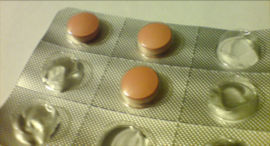- Atovaquone/proguanil
-
Atovaquone/proguanil Combination of Atovaquone Antimalarial medication Proguanil Antimalarial medication Clinical data AHFS/Drugs.com monograph Licence data US FDA:link Pregnancy cat. ? Legal status POM (UK) ℞ Prescription only Routes Oral Identifiers ATC code P01BB51 PubChem CID 11954242 ChemSpider 21230364 
KEGG D02472 
 (what is this?) (verify)
(what is this?) (verify)The drug combination atovaquone/proguanil (INNs, trade name Malarone) is an antimalarial medication used in both the treatment and prevention of malaria, commercially available from GlaxoSmithKline since 2000. Atovaquone alone is not indicated for treatment or prevention of malaria as monotherapy (i.e. without proguanil).
A "standard" tablet of Malarone contains 100 mg of proguanil hydrochloride and 250 mg of atovaquone. A "pediatric" tablet of Malarone contains 25 mg of proguanil hydrochloride and 62.5 mg of atovaquone.
Contents
Medical use
Treatment
The adult treatment dose is four "standard" tablets once a day for three days. In children, the drug is prescribed by body weight:
- 11 to 20 kg: 1 "standard" tablet once daily for 3 days;
- 21 to 30 kg: 2 "standard" tablets once daily for 3 days;
- 31 to 40 kg: 3 "standard" tablets once daily for 3 days;
- 41 kg and above: use adult dose.
Malarone is not licensed for use in children weighing 10 kg or less. The "pediatric" tablets are not used in malaria treatment.
The advice of a specialist should always be sought when starting malaria treatment. Malarone should not be used to treat severe malaria, when an injectable drug (quinine or artesunate in the UK; quinidine in the US) should be used instead.
Prevention
Medical advice should always be taken before choosing a drug for malaria prevention. Because some strains of malaria are resistant, Malarone is not effective for malaria prevention in all parts of the world. It must be taken with a fatty meal or at least some milk to be absorbed adequately.
The adult dose is one "standard" tablet daily starting one or two days before traveling into a malaria-endemic area, and continuing throughout the stay and then for another 7 days after returning from the malarious area.
The child dose is prescribed according to body weight:
- 11–20 kg: 1 "pediatric" tablet once daily;
- 21–30 kg: 2 "pediatric" tablets once daily;
- 31–40 kg: 3 "pediatric" tablets once daily;
- 41 kg and above use adult dose.
The duration of treatment is the same as for adults.
Resistance
Proguanil acts as a mitochondrial sensitiser and synergizes with atovaquone; also, there is a high natural frequency of cytochrome B mutants which leads to a high failure rate if atovaquone is used on its own to treat malaria. Specific mutations (Y268S, Y268C) have been shown to confer resistance in vivo,[1][2][3] but there are other mechanisms of resistance that remain unknown.[4]
Adverse effects
Some people have difficulty sleeping (nightmares, incoherent dreams) while taking Malarone. Headaches and stomach irritation have also been reported, though this can be helped by taking the drug with food or a milky drink. Muscle fatigue and hard stools have also been reported.
Mechanism of action
Atovaquone selectively inhibits the parasitic electron transport chain.
Proguanil, via its metabolite cycloguanil, functions as a dihydrofolate reductase inhibitor, halting parasitic deoxythymidilate synthesis.[5]
References
- ^ Färnet A, Lindberg J, Gil P, et al. (2003). "Evidence of Plasmodium falciparum malaria resistant to atovaquone and proguoanil hydrochloride: case reports". Brit Med J 326 (7390): 628–29. doi:10.1136/bmj.326.7390.628. PMC 151974. PMID 12649236. http://www.pubmedcentral.nih.gov/articlerender.fcgi?tool=pmcentrez&artid=151974.
- ^ Fivelman QL, Butcher GA, Adagu IS, et al. (2002). "Malarone treatment failure and in-vitro confirmation of resistance of Plasmodium falciparum isolate from Lagos, Nigeria". Malaria J 1: 1. doi:10.1186/1475-2875-1-1.
- ^ Schwartz E, Bujanover S, Kain KC (2003). "Genetic confirmation of atovaquone-proguanil-resistant Plasmodium falciparum malaria acquired by a nonimmune traveller to east Africa". Clin Infect Dis 37 (3): 450–51. doi:10.1086/375599. PMID 12884171.
- ^ Wichmann O, Muehlen M, Gruss H, et al. (2004). "Malarone treatment failure not associated with previously described mutations in the cytochrome b gene". Malaria J 3: 14. doi:10.1186/1475-2875-3-14. PMC 425592. PMID 15186499. http://www.pubmedcentral.nih.gov/articlerender.fcgi?tool=pmcentrez&artid=425592.
- ^ http://us.gsk.com/products/assets/us_malarone.pdf
Categories:- Combination drugs
- Antimalarial agents
- Antiprotozoal agents
Wikimedia Foundation. 2010.

